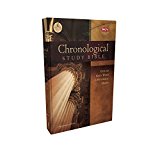The Chronological Study Bible: New King James Version. Nashville, TN: Thomas Nelson, Inc., 2008. 1696 pp. Hardcover, $44.99.
Fans of the New King James Version will be pleased with this new and innovative study Bible from Thomas Nelson. Students of the Word have often sought to understand when events occurred as they unfolded within the Scriptures. How do the various prophecies of Isaiah fit with the events unfolding within 2 Chronicles? Which passages from Jeremiah fit with King Jehoiachin’s exile and release? As the events within Acts unfolded, when and where did Paul write each of his epistles? Answering these questions, even with the use of previous study Bibles, often required a good memory, a set of charts, and a willingness to do a little digging. Not anymore.
Thomas Nelson has attempted to structure (as much as possible) a study Bible according to when each passage of Scripture took place in history. Passages are listed as they occurred, with some books (Genesis, Exodus, 1 Corinthians, etc.) appearing intact while others (Psalms, Ezekiel, all four Gospels) are interspersed amongst each other, often out of numerical order (ex. chapter 21 of Ezekiel appears between chapters 23 and 24). This functions very effectively from a historical perspective, especially when reading 1 and 2 Kings and 1 and 2 Chronicles (as well as most of the OT Prophets). For instance, by reading pages 608 to 619 the reader will have interacted with passages from 2 Chronicles, 2 Kings, Isaiah, and Micah! Helpful time tables appear throughout, giving the reader a birds eye view of the events as they unfold.
Printed on durable color paper with an easy-to-read Times New Roman 11-point font, the hardcover edition appears very strong. Every page contains visually appealing artwork and watermarks. Several full-color maps, twelve pages for notes, a glossary, cultural and historical topics listing, a healthy 200- page concordance, and other tools are included.
While the Scripture organization is obviously convenient for reading through the events as they occurred chronologically, the reader must remember that in order to quickly find a particular passage, he will have to refer back to an index, rather inconveniently located at the back of the Bible. After having to use this several times I was reminded of what it felt like to be a beginning Bible student with no real understanding of how the books of the Bible fit together! Another drawback with reading chronologically is that, as several books are cut into pieces, you lose each author’s original intent in providing a coherent message. This may not appear particularly noticeable when reading 2 Samuel mixed up with 1 Chronicles and Psalms, but it is extremely noticeable when reading the Gospels. Care should be taken when providing this book to an unbeliever, since confusion will likely abound as passages originally intended for unbelievers (e.g., The Gospel of John, cf. 20:31) are lumped together with messages intended for believers (Synoptic Gospels). Also worth mentioning is the fact that the articles relating to prophetic passages reveal a decidedly preterist viewpoint.
Still, I found this study Bible very interesting and a healthy addition to my Bible reading plan. The pages and illustrations are alluring, and the approach to understanding the Bible chronologically makes it a nice addition to any theological library.
Shawn Leach
Pastor
Minneola Community Church
Minneola, KS

